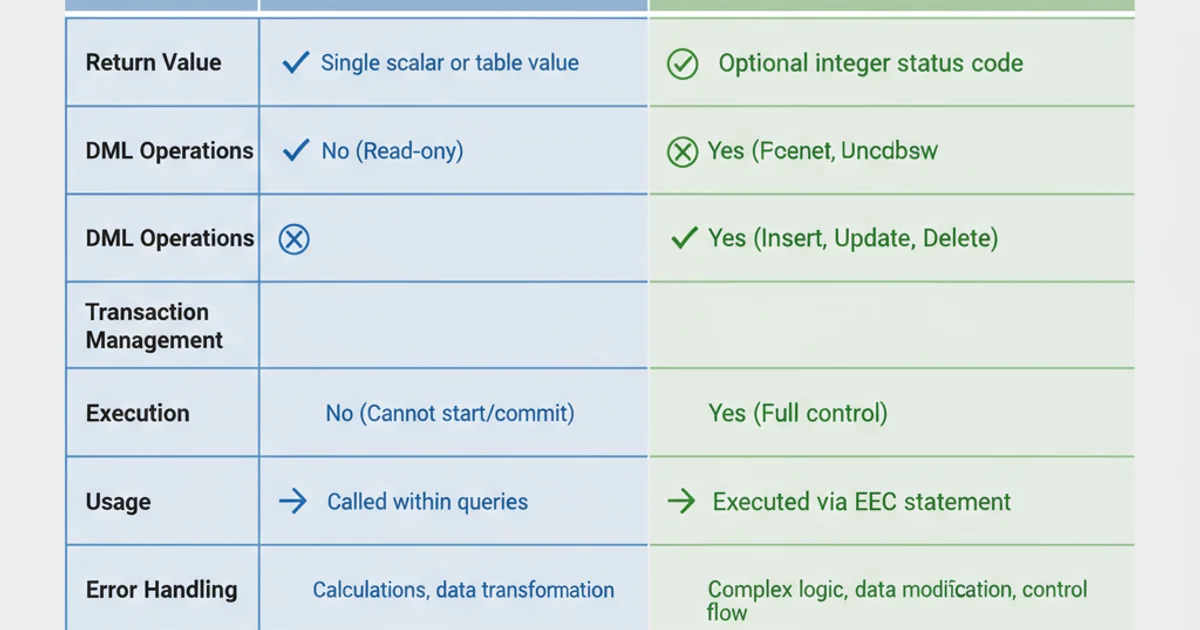Function vs. Stored Procedure in SQL Server
SQL Server Functions vs. Stored Procedures: A Comprehensive Guide

Understand the key differences, use cases, and performance implications of SQL Server functions and stored procedures to make informed design decisions.
In SQL Server, both functions and stored procedures are powerful tools for encapsulating business logic and enhancing database operations. While they both allow you to execute a predefined set of SQL statements, they serve distinct purposes and have fundamental differences in their behavior, capabilities, and ideal use cases. Choosing between a function and a stored procedure is a common design decision that can significantly impact the performance, maintainability, and reusability of your database code. This article will delve into these differences, providing clear examples and best practices to help you decide which to use when.
What is a SQL Server Function?
A SQL Server function is a database object that accepts input parameters, performs a calculation or action, and returns a single scalar value or a table. Functions are primarily designed for computations and data manipulation within queries, behaving much like functions in programming languages. They can be used in SELECT statements, WHERE clauses, HAVING clauses, and even as default values for columns. Functions are generally categorized into Scalar-valued Functions (SVFs) and Table-valued Functions (TVFs).
CREATE FUNCTION dbo.CalculateTotalOrderAmount
(
@OrderID INT
)
RETURNS MONEY
AS
BEGIN
DECLARE @TotalAmount MONEY;
SELECT @TotalAmount = SUM(UnitPrice * Quantity)
FROM OrderDetails
WHERE OrderID = @OrderID;
RETURN @TotalAmount;
END;
Example of a Scalar-valued Function (SVF) calculating total order amount.
What is a SQL Server Stored Procedure?
A SQL Server stored procedure is a batch of SQL statements that are stored in the database and can be executed by name. Procedures are designed for performing a sequence of operations, which can include data modification (INSERT, UPDATE, DELETE), complex business logic, and even returning multiple result sets or output parameters. Unlike functions, stored procedures do not necessarily return a value, and if they do, it's typically through output parameters or a return status code, not as a direct return value that can be used in an expression.
CREATE PROCEDURE dbo.UpdateProductInventory
@ProductID INT,
@QuantityChange INT
AS
BEGIN
SET NOCOUNT ON;
UPDATE Products
SET StockQuantity = StockQuantity + @QuantityChange
WHERE ProductID = @ProductID;
IF @@ROWCOUNT = 0
BEGIN
RAISERROR('Product not found or no update occurred.', 16, 1);
RETURN -1; -- Indicate an error
END
RETURN 0; -- Indicate success
END;
Example of a Stored Procedure updating product inventory and handling errors.
Key Differences and Use Cases
The fundamental distinction lies in their purpose and how they interact with SQL statements. Functions are primarily for computations and can be embedded within queries, while stored procedures are for executing a series of actions and are typically called as standalone commands. This difference dictates their capabilities regarding data modification, transaction management, and error handling.
flowchart TD
A[Start]
A --> B{Is a single value/table needed within a query?}
B -->|Yes| C[Use a Function]
C --> D{Can it be deterministic?}
D -->|Yes| E[Scalar-valued Function (SVF)]
D -->|No| F[Table-valued Function (TVF)]
B -->|No| G{Are multiple actions/side effects needed?}
G -->|Yes| H[Use a Stored Procedure]
H --> I{Does it need to modify data?}
I -->|Yes| J[Stored Procedure (DML operations)]
I -->|No| K[Stored Procedure (Complex logic/multiple result sets)]
E --> L[End]
F --> L[End]
J --> L[End]
K --> L[End]Decision flow for choosing between a Function and a Stored Procedure.
SELECT statements.Comparison Table: Functions vs. Stored Procedures
To further clarify the distinctions, here's a direct comparison of their characteristics:

Key differences between SQL Server Functions and Stored Procedures.
Performance Considerations
While both can improve performance by reducing network traffic and enabling query plan caching, their usage patterns can lead to different performance characteristics:
- Functions in
WHEREclauses: Using scalar-valued functions inWHEREclauses can prevent the optimizer from using indexes effectively, leading to full table scans and poor performance. This is often referred to as 'sargability' issues. - Table-valued Functions (TVFs): Inline TVFs (iTVFs) are generally optimized well as their logic is expanded directly into the calling query. Multi-statement TVFs (mTVFs), however, can suffer from poor cardinality estimates, leading to inefficient query plans.
- Stored Procedures: Procedures are often pre-compiled, and their execution plans are cached, which can lead to faster execution for repeated calls. They are also better suited for complex operations involving temporary tables and multiple DML statements, where the optimizer has more context to create an efficient plan.
WHERE or JOIN clauses, especially scalar-valued functions, as they can severely impact query performance by inhibiting index usage. Consider rewriting queries or using computed columns if performance is critical.Best Practices
Adhering to best practices ensures optimal performance and maintainability:
- Use Functions for: Calculations, data formatting, returning a single value or a small result set that can be integrated into a query. Ensure they are deterministic and free of side effects.
- Use Stored Procedures for: Complex business logic, data modification (INSERT, UPDATE, DELETE), transaction management, returning multiple result sets, or when you need to control execution flow with
IF/ELSE,WHILEloops. - Avoid: DML operations in functions, excessive nesting of functions, and using multi-statement TVFs unless absolutely necessary and thoroughly tested for performance.
- Parameterization: Always use parameters for both functions and procedures to prevent SQL injection and improve plan reuse.